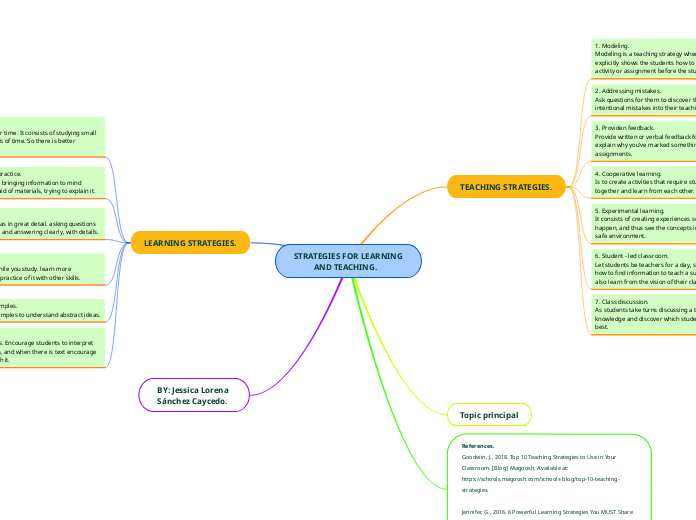STRATEGIES FOR LEARNING
AND TEACHING.
TEACHING STRATEGIES.
1. Modeling.
Modeling is a teaching strategy where a teacher explicitly shows the students how to complete an activity or assignment before the students begin.
Example:
A child use modeling for learn the pronunciation of any word.
2. Addressing mistakes.
Ask questions for them to discover the mistake. Inserts intentional mistakes into their teaching materials.
Example:
Create intentional spelling and grammatical errors.
Mispronounce a term and see if learners realize it.
3. Providen feedback.
Provide written or verbal feedback for individual or group. explain why you’ve marked something incorrect on tests and assignments.
Example:
A boy submits an almost perfect job, but gets a grade of 4. The teacher explains what mistakes he had and the solution, but congratulates him for his work being well done.
4. Cooperative learning.
Is to create activities that require students to work together and learn from each other.
Example:
The tea party, the round robin and carousel
are activities that use cooperative learning.
5. Experimental learning.
It consists of creating experiences so that they see how things happen, and thus see the concepts in action, practicing in a safe environment.
Example:
Experiments, or simulations use the
experimental learning.
6. Student - led classroom.
Let students be teachers for a day, so they learn things, like how to find information to teach a subject. Other students will also learn from the vision of their classmates.
Example:
A class explained by a child.
7. Class discussion.
As students take turns discussing a topic, you can assess their knowledge and discover which students grasp the concepts best.
Example:
Forums and discussing.
Topic principal
References.
Goodwin, J., 2018. Top 10 Teaching Strategies to Use in Your Classroom. [Blog] Magoosh, Available at: https://schools.magoosh.com/schools-blog/top-10-teaching-strategies.
Jennifer, G., 2016. 6 Powerful Learning Strategies You MUST Share with Student. [Blog] cult of pedagogy, Available at: https://www.cultofpedagogy.com/learning-strategies/.
LEARNING STRATEGIES.
1. Spaced practice.
Space your study over time. It consists of studying small things in short periods of time. So there is better learning.
Example:
Study 10 minutes every 3 hours specific topics.
2. Retrieval practice.
It consists of bringing information to mind without the aid of materials, trying to explain it.
Example:
A child remembers what he learned in class and writes down the ideas. Then compare this with his notes to check for possible mistakes.
3. Elaboration.
Explain and describe ideas in great detail. asking questions about the study material and answering clearly, with details.
Example:
Summarizing, paraphrasing, creating analogies.
4. interleaving.
Switch between ideas while you study. learn more effectively if we mix our practice of it with other skills.
Example:
If someone needs to learn words then instead of learning all the words from one topic before moving on to words from the next one, they can mix words from the different topics as they study.
5. Concrete examples.
Use specific examples to understand abstract ideas.
6. Dual coding.
Combine words and visuals. Encourage students to interpret pictures in their own words, and when there is text encourage them to make a picture with it.
Example:
Diagrams, timelines, poster, infographics.
